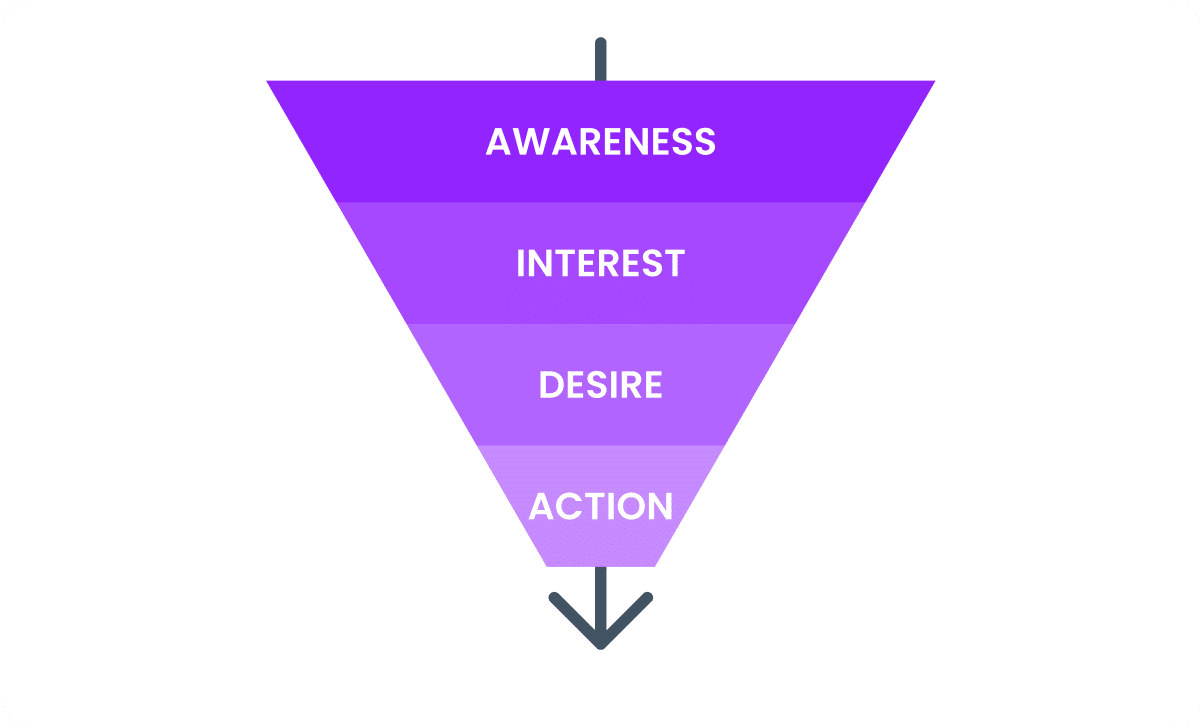

Drawing a person to your website for the first time is a win. Focusing too much on first-time website visitors comes at a cost. You may neglect to build an engaged audience. If you have an effective content strategy in place, your next priority should be to grow engagement.

Start By Choosing Your “Leading Indicator” KPI For Conversions
Most businesses have a clear end result in mind for their website. They want paying subscribers, purchases, or another critical conversion. Exclusively focusing on this end result can hurt your efforts because these conversions tend to be lagging indicators. They are a result of effective marketing and engagement.
Instead, it is often more helpful to focus on leading indicator measures that you can control more directly. To clarify the difference between leading and lagging indicators, consider sales: a salesperson is ultimately responsible for achieving a specific sales volume. That sales volume is a lagging indicator and one that is not entirely in their control as very real,external factors can delay or prevent a sale from moving to “Closed Won.”
Instead, effective salespeople focus on lead indicators that predict success, like prospecting activity and pipeline generation. The work of building an engaged online audience is no different. You can’t directly generate engagement, but you can set the conditions that make engagement more likely, including higher conversion rates.
Potential lead indicators that show your website’s online audience is engaging effectively include
- Time on site. Usually, higher time on site is a good sign that a user is interested in what they see. This metric needs to be balanced with the KPIs noted below/
- Pages per session. Tracking pages per session is even more helpful because you can see which pages draw the most interest.
- Opt-in activity. Earning permission to follow up with the user with browser notifications, text messages, email, and other means is even more valuable.
Once you have clarity on your top metrics, use the following strategies to grow audience engagement.
Strategy 1: Build A Comment #1 Strategy To Jump Start Engagement
The “herd instinct” is powerful in the online context. It’s far more appealing to join an existing conversation compared to attempting to start one from scratch. The traditional way to solve this challenge is to optimize the call to action, leverage controversy and make commenting irresistible. All of those efforts are worthwhile.
Yet, there is more we can do to make commenting more appealing. Instead of leaving comments to chance, develop a “Comment #1” strategy. In other words, don’t just trust to hope that your content will get comments. Instead, use an outreach strategy to engage specific people to encourage comments.

Your outreach strategy to spark comments will depend on the audience and resources you have. Get started with the following ideas:
Encourage Your Journalists To Start Commenting
According to the Center for Media Engagement, 60% of Americans want journalists to clarify factual matters in the comments section. That tells us that many people are hungry for engagement from journalists in the comments section.
Even if you don’t have a factual oversight or mistake to clarify, there are other ways to leverage comments. For example, you might ask a journalist who covers a different beat to post a question to spark a discussion. Seeing a comment from one of your well-known personalities can do wonders to lift engagement for the rest of the day.
Past Commenters
Reach out to past commenters and ask them to comment on your latest content. While you can use manual methods to invite more comments, automation is even more powerful. For example, you might collect first-party data about the types of stories that your audience is interested in so that you can invite them to be the first to comment or share about future articles.
Use Social Media
Share your content on social media platforms and invite people to ask questions. The downside is that these social media responses may not always lead people back to your website. The risk of engagement happening away from your website can be mitigated by giving your audience a reason to come back and see the original content.
Finally, try to get the first comment fast, ideally within an hour of the content being published. When other people see comments on your content, they’ll feel more safe sharing their thoughts.
Strategy 2: Highlight The Best User Generated Content (And Hide The Worst)
Larger websites and publishers suffer from a different challenge – a high volume of comments. Inevitably, only a tiny portion of these comments are engaging and relevant. In other words, you have to face the challenge of moderating user-generated content.
Let’s say you’re running an online event with Arena Live Chat. Your audience is engaged and sharing a wide variety of questions and comments. Then you see that some of your audience is distracted from the core themes, like the new features you’re announcing. Arena gives you a few ways to shape the flow of the conversation.
Crowdsource Moderation
Keeping track of all the comments in a chat session in a significant online event may feel overwhelming. You can solve this challenge by inviting your audience to participate in the moderation process. Take a few moments at the event’s start to explain your ground rules, including when and how to report inappropriate content. In this way, your audience can help to turn the tide of irrelevant comments.
Use Moderation To Maximize Brandsafe Experiences
Some online events call for a different approach. Let’s say your online experience includes important customers and executives. To ensure a brand-safe experience, it is wise to take a more active role in moderating user content. Arena supports this need by allowing you only to display comments and questions manually approved by your team. This approach takes more effort, but it yields a great result.
In some cases where emotions are running hot, your event might face a different problem: profanity. Arena can help you to manage this threat as well with automation moderation. The built-in profanity filter and AI moderation automatically allows you to set a sliding scale for brand safety to blog and prevent a wide range of offensive, and potentially offensive content.
Use The Power of Praise
Restricting user content isn’t your only way forward. You can also use your status as the event host or moderator to praise relevant, engaging content. To ensure you apply this practice, make a note to look for quality comments and questions as the event unfolds. When a great comment comes in, take a moment to recognize it and thank the participant.
By showing appreciation for quality audience engagement, your audience is more likely to stay focused on the event.
Strategy 3: Remove Speed Bumps From User Registration
Sometimes, our efforts to deliver a great audience experience have unexpected consequences. For example, many publishers require users to register for a free account before commenting and engaging. That small speedbump helps to discourage “Internet trolls” – to a degree – but it can also stop casual website visitors from engaging with your website’s content.
The solution is to take a fresh look at your user registration process. For example, give users multiple opportunities and places to register for an account. Taking the time to clear roadblocks from user registration is important because registered users are much more valuable.
According to International News Media Association, about 10% of registered users on news websites typically convert to paying subscribers. That’s far better than typical ecommerce conversion rates, which rarely exceed 3%.
Strategy 4: Mine Your Comments For Future Engagement Ideas
Past comments on your content – especially on your website – are a rich source of insight. That information can help you to lift engagement quickly. Reading the comments on their own will give you clues about your audience. For example, commenters who share personal stories are more likely to trigger others to respond. If you see that pattern, look for ways to encourage readers to share more stories in future comments.
The true magic happens when you look at comments as one part of a broader first-party data strategy.
Strategy 5: Leverage First-Party Data Across Platforms
Personalized marketing and engagement strategies are some of the most powerful ways to lift conversion rates. The key to doing personalization work at scale is using multiple forms of first-party data to verify your audience engagement.
Start with the following types of user data to inform your personalization efforts:
- Content Interactions. Look for patterns in how your users engage with your content, such as comments, votes, and shares.
- Email/App Interactions. Some of your audience may engage with your content off your website. Check to see if those patterns are significantly different from website interactions.
Get The Right Tools To Increase Conversion Rates Across Your Funnel
Converting a passing website visitor is tough. You don’t have to suffer single-digit conversion rates, though. Developing an engaged audience is one of the best ways to drive more traffic and revenue. Find out more about Arena’s solutions for publishers.



